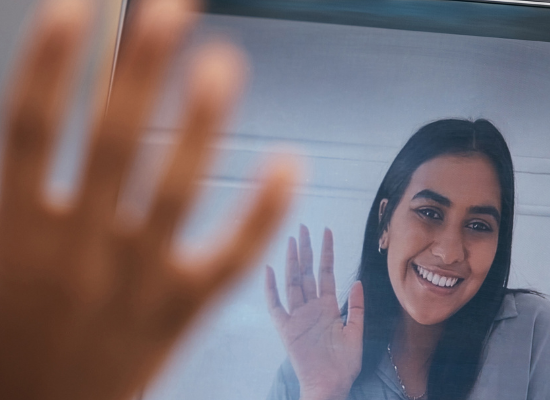
Stephanie Hepburn is a writer in New Orleans. She is the editor in chief of #CrisisTalk. You can reach her at .
“As I started feeling more suicidal, I started researching what was happening to me,” says DeQuincy Meiffren-Lézine. He spent hours in his college library reading Edwin Shneidman, who is known as the father of suicidology. In his book “The Suicidal Mind,” Shneidman wrote the most critical question to ask a suicidal person isn’t about “family history or laboratory tests of blood or spinal fluid, but ‘where do you hurt’ and ‘how can I help you?’”
DeQuincy’s desire to learn more about suicide wasn’t to help himself but instead to know how to convey his experience to friends and family and teach people the warning signs of suicide. “I felt things were pretty much done for me, but I could share enough so other people could be helped and saved.” It was ‘95, and he was in his first semester of college at Brown University.
He began writing about his life, often in the past tense. “It’s not uncommon for people as they’re nearing suicide to say ‘this is what happened’ or write about themselves or their life in a past tense,” says DeQuincy. “A lot of my writing had that flavor. It was like, ‘When you read this later, here’s what led me to this inevitable conclusion.’”
These writings also included what could have been done to prevent his suicide. However, DeQuincy’s objective was to relieve, not assign, his loved ones of culpability. He says this is partly because as far back as he can recall, he saw himself as a helper. “I felt so much pain that I wanted to die,” he shares, “but also, on behalf of my friends, I tried to find a way to hold on.”
DeQuincy says people who believe suicide to be a selfish act flatten the complexity of suicidality. “Maybe at the decision point, it’s selfish, but a life in pain is not, and that has lasted for the longest period of time.”
As Thanksgiving neared, he decided to hold off for another week. “My best friend, MaryAlice, had a trip planned to visit someone in Japan,” he says. “I wanted her to explore what she was exploring and not have to worry.”
When MaryAlice returned, DeQuincy finalized his plans. He’d written a suicide note, tucking it neatly into an envelope in his room. In the school computer lab, he started sending final emails. “Friends who were online tried to keep me online while they contacted Brown’s administration,” he says. Campus police showed up and took him to the university’s psychological services.
Then, the university gave him an ultimatum: sign yourself into Butler Hospital or face expulsion.
The nearly weeklong hospitalization left DeQuincy with the overarching sentiment that he “never, ever” wanted to go back. The experience also fueled what became his career in suicide prevention and advocacy.
While he found the hospital setting frustrating, he says two positives emerged. He had a memorable conversation with a psych tech, and interacting with other people who were hospitalized helped shatter his own biases.
Late one night at the hospital, DeQuincy and a psych tech discussed having a family with substance use issues. “He gave me a copy of ‘It Will Never Happen to Me!’ by Claudia Black.” The book dives into the survival roles and coping behaviors of children who grow up in an addictive household and the impact on them throughout their lives. He’s carried this conversation with him ever since, giving him better insight into his own childhood trauma.
Speaking to fellow patients was similarly invaluable. “It helped break stereotypes I had about people in the hospital or who had depression or bipolar disorder,” he says. Connecting with them made him realize that mental health affects everyone, regardless of age and group. “I thought, ‘Oh, these are just people,’” he laughs. “We are all struggling and in this hospital.”
When DeQuincy was discharged from the hospital, he immediately began the first university campus-based chapter of the Suicide Prevention Action Network. He also served on a SPAN-led steering committee to create a national suicide prevention strategy, which laid the groundwork for the 1999 Surgeon General’s Call to Action to Prevent Suicide and the 2001 National Strategy for Suicide Prevention: Goals and Objectives for Action. “Our steering committee was, in many ways, the early predecessor to what would later become the Action Alliance,” says DeQuincy.
Today, he’s a psychologist and suicidologist. What he wishes he could convey to his younger self, and to young people today, is to be open to possibility. “It’s possible that things are going to be crappy,” he says, “but it’s also possible that they will go well and change in positive ways.” “You’re going to have both. That’s just life.”
Shneidman talks about retrospective analysis in his book “Autopsy Of A Suicidal Mind.” “Hindsight is not only clearer than perception-in-the-moment but also unfair to those who actually lived through the moment,” he wrote. DeQuincy agrees but highlights that looking back has allowed him to shift his mindset.
For survival, people are primed to look out for danger. DeQuincy believes that causes people to pay more attention to what’s going poorly in their lives. Looking back at his life, he sees both the challenges he’s faced and the opportunities that were there too. “I had no idea how I was going to pay for college, and then the following day, someone came to my high school and said, ‘Hey, we have his scholarship program.” When he started at Brown, he didn’t know anyone. The next day he met MaryAlice. “We’re not really able to predict what’s coming next; that goes for both the good and the bad.”
However, when someone is experiencing suicidality, DeQuincy says it’s unrealistic to expect them to switch to a positive mode. Trying to remember the good that’s happened in the past can help some people, but for others, it can feel worse to have people expect them to see a positive future. “It’s like, ‘Great, I’m experiencing tremendous pain and failing at this,’” he says. “That’s a lot to grapple with all at once.”
Instead, he focuses on being present in the moment and sensory awareness, drawing in dialectical behavior therapy skills. “For example, it’s a sunny day, and I can see the blades of grass moving in the wind, looking like waves,” he says. Even so, stillness, when he’s in pain, doesn’t always work. “When I’m in pain, I feel it more as anger, so sitting still isn’t what helps me the most.
“Taking some kind of action like going for a walk or working in the garden gives me a super tangible, positive result at the end.”
Determining what’s helpful and isn’t is deeply personal and can change over time, says DeQuincy. That’s why it’s critical to develop a safety plan, an intervention codeveloped by Barbara Stanley and Gregory K. Brown, and frequently interact and revisit each part. For example, if a young person realizes they’re shifting into a negative mindset — focusing on what’s wrong, it may be time for them to reexamine the warning signs on their safety plan. “Maybe write down what’s different or what came first,” he says. “That also shifts the mind into analysis instead of just feeling pain.”
He says it’s also vital to examine whether the distractions on a safety plan are still working for the person. “In life, things keep changing, and so, when it comes to my safety plan, I force myself to flow with what’s working and revise what’s not.”









